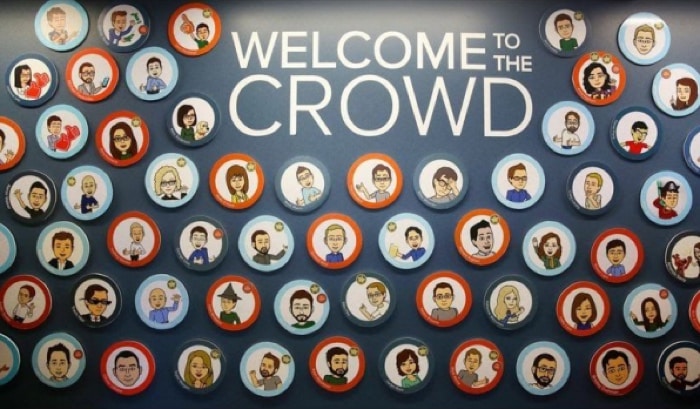10 Dynamic Employee Onboarding Ideas

For many companies, a new year might mean that there’s an opportunity to hire new employees.
While initially exciting, recruiting can be an exhausting process, and interviewing can feel tedious. By the time those processes are “over” (are they ever really over?), it’s not unlikely that hiring managers would leave the thoughts of employee onboarding behind.
While this is understandable, it’s a mistake. Onboarding is the second most important HR practice after recruiting, in regards to economic influence on a business. In other words, onboarding is an incredibly important step in hiring new employees. It shouldn’t be put together at the last moment, let alone forgotten about completely.
Whether you’re starting your onboarding program up for the first time or looking for some new, unique ideas, this is the year to get it right.
Creative employee onboarding ideas
Traditional onboarding often entails boring paperwork, endless PowerPoints, cringey videos from the 90s, and uncomfortable icebreakers. In other words, it’s not always a great experience for new employees. And while this process might be at the bottom of your to-do list to improve, know this: great employee onboarding can improve retention by 82%. That’s no small number.
There’s more to your company than those monotonous activities, and it’s never too late to get a little creative in order to show that off.
Below, we’ve listed some of the ways to make onboarding a more exciting process for both new employees and their hiring managers.
1. Check off the basics
Before you come up with any wild ideas for how you can incorporate your company culture into onboarding, it’s important not to forget the basics of onboarding.
Things such as going over company policies, providing new employees with IT equipment, and check-ins are an absolute must. Make sure that these things are prominent on your onboarding checklist—while these things might be the least exciting part of the onboarding process, they’re absolutely imperative for the success of any employee.
2. Don’t wait until day one
The anxiety behind a new job is real, and not hearing from an employer in between their acceptance and their first day doesn’t help.
In order to alleviate some stress, start onboarding before they walk through the door. A helpful email from HR outlining what to expect their first few days, a quick phone or video call with their new manager so that they can introduce themselves, providing them with access to onboarding software to encourage communication, or even a virtual tour of the office are some of the ways that you can reach out to new hires to keep them out of the dark.
3. Make their first day one to remember
First impressions matter. While you may think that you giving your new employee their job is a first impression, the true test comes on their first day. Creating a friendly, warm, welcoming environment won’t go unnoticed, but if you truly want to blow them out of the water, do the following:
Provide them with some swag. Neatly placing a branded out water bottle, T-shirt, and even a few branded stickers or office supplies to get them started will be the first step to getting an employee truly feeling like part of the team.
Take them out to lunch. Giving new hires a chance to get to know yourself and one another in a less rigid environment makes it easier for them to create casual relationships first, which can then be molded into professional ones later down the line.
While these things feel standard, you’d be surprised at how many companies prefer to have their employees spend their first day filling out paperwork and being sent home early. While that might sound great for some people, it’s not as much fun as telling someone that you spent the morning designing your own custom Bitmoji to be slapped up on the office wall (that’s what G2 did for us!)

4. Keep it creative
One of the most common things that people experience in the onboarding process is boredom. Referenced above, those PowerPoints and paperwork are often necessary, but don’t have to be the only way that you can teach new employees about what it means to work for your company.
Redesigning your employee handbook with some desktop publishing software to make it more friendly, colorful, and attractive is a step to consider; while the information itself can be dry, you’d be surprised what a great infographic or two could do for your new hires.
Physically creative materials are plenty, but if you really want to impress, take the time to make a more meaningful, interactive, and creative experience for new employees.
Replacing icebreakers with scavenger hunts around the office or assigning “quests” like finding the coffee machine or giving the CEO a high five before lunchtime are more than just fun; they encourage collaboration, communication, and teamwork, right off the bat.
5. Introduce them to the team
As technology consumes our lives, it seems that a quick email or Slack message may be all you have to do as an employer to introduce a new employee to the team.
But now, more than ever, it’s important to make things personal. There’s no better way to do so than by taking the time to introduce your new employees to their team with good, old fashioned verbal communication.
Slack and email are fast and seemingly intimate, but they don’t prompt a conversation in the same way that good, old fashioned face-to-face interaction does. By setting up a meeting or even a quick lunch with a few team members to join your new employee, you’ll expose them to new people, give them a chance to ask questions to those who will have the same goals as they do, and begin to build more relationships than they would if they were introduced over a screen.
If you have remote employees and onboarding has to take place via a video conferencing tool, make sure that you’re engaging all employees. Ask everyone to keep their video on and try to encourage all participants to chat and contribute. Consider having a virtual lunch with their new team members where each member conferences in and chat while eating lunch, almost replacing the water-cooler chat that in-office team members get.
6. Assign them a mentor
Even with that in-person introduction, there’s a chance that your new employee may not feel comfortable approaching those same people with questions.
Assigning a mentor to new employees can prevent the event of questions being left unanswered. Having that mentor set up some 1:1 time with that new employee for their first few weeks as they settle in to talk anything feedback, company, and culture can make a world of difference in someone’s confidence.
7. Rotate managers amongst associates
If you’re hiring a manager, it’s never a bad idea to create a program in which they can meet multiple employees in other roles, both higher and lower in the hierarchy than them.
While managers can be onboarded in the same way as an associate in the beginning, it’s important to make sure that they are exposed to the employees who will be working under them and incorporate an educational experience in which they’ll learn the ins and outs of the company, from the bottom up. The day-to-day tasks that they’ll be assigning those below them are just as important as learning internal communication skills with those above them, and week one is as good a place to start as any.
8. Rotate associates amongst higher-ups
It’s just as important for a new associate to become familiar with company management as it is the other way around.
Setting up meetings for a group of new hires with their department manager and even C-Suite executives can help them feel more at home and comfortable asking questions, while providing higher level employees an opportunity to share stories, tips, and experiences to help new hires adjust to their new environment.
9. Don’t stop after week one
Onboarding isn’t a one-week process, and it might not even be a one month one. Research has shown that it may take six to 12 months for an employee to feel like they have completely onboarded into a company. Being transparent with employees, providing training opportunities, scheduling check-in meetings on a regular basis, and giving them chances to transition smoothly from one stage of their career into the next are all part of the onboarding process that hiring managers are responsible for. Have them keep track of their training progress throughout the first week, month, and year with a project management tool.
10. Ask for feedback
Whether your company’s onboarding process lasts two weeks or two months, it’s always important to ask for feedback. Although you and your team have taken the time to design the process that new employees go through, they’re the ones experiencing it. Some may wish that something had been explained sooner, some may prefer to have a vegetarian option at lunch, and some may prefer more time to do one activity than another.
Be open to all input that these new employees are providing you, and keep track of what they’re saying. You can even create a survey with both qualitative and quantitative options to present to higher-ups at the end of a new process.
New Year’s resolution: create a great onboarding program
A new year doesn’t just mean new hires – it means new experiences. Providing both your new hires and your hiring team with something fresh to implement and participate in can motivate not only new employees, but your more seasoned ones to work harder, smarter, and have a sense of belonging where it matters most.
By Daniella Alscher, Guest Contributor
Daniella Alscher is a content marketer at G2.com with a focus on marketing automation and graphic design. When she’s not working, she’s hanging out with a good book, watching an intriguing cultural documentary, or eating a PB&J.

Simplify HR management today.
Simplify HR management today.
Navigating the Complexities of Healthcare Recruitment
The healthcare sector is renowned for its rewarding nature, offering professionals the chance to significantly impact individuals’ lives by aiding in their recovery from various ailments and conditions. However, for those tasked with recruitment within this sector, the challenges are plentiful. Delve into our in-depth guide for an array of strategies to elevate your healthcare…
Read MoreHow Improving Candidate Engagement Influences the Hiring Process
Applicants invest considerable time, effort, and thought into their job applications. Regrettably, it’s all too common for employers to delay responses, with some failing to provide any follow-up whatsoever. Such practices can have a negative effect on the candidate experience, influencing your organization’s hiring efficiency and reputation. Ensuring a positive experience for candidates is crucial…
Read More




